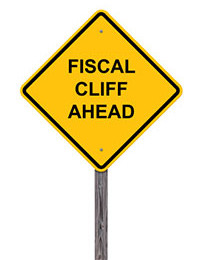How Congress can avoid the “transportation cliff”

By Randal O'Toole
President Obama’s recent visit to the Tappan Zee Bridge in New York was intended to push Congress to approve billions of dollars in infrastructure spending increases. But throwing more money at transit just puts more cash into the hands of government contractors, while doing little for commuters.
The federal Highway Trust Fund is expected to run out of money in a few months, and unless Congress replenishes it, state highway projects will supposedly grind to a halt. Special interest groups are working overtime to create a crisis atmosphere about the so-called “transportation cliff.”
In fact, this is more of a pothole than a cliff. Even if Congress doesn’t immediately restore the fund, states will get by with their own funds and through short-term loans.
The real issue is what happens after the cliff. On September 30, Congressional authority for the federal gas tax and highway and transit programs is set to expire. The artificial handwringing over the cliff is really just posturing for the debate over the reauthorization of those programs.
Most of the handwringing is coming from groups that want to see a huge increase in spending on transit. Transit carries just 1 percent as much travel as highways, yet 20 percent of federal gas taxes are diverted to transit, and many groups want even more.
Such subsidies do little for transit ridership. Since 1970, this country has spent around a trillion dollars subsidizing transit, yet ridership has fallen from 49 annual trips per urban resident in 1970 to just 44 trips today.
The push for transit spending comes partly from contractors who profit from building expensive new transit lines. The average light-rail line being planned or built today costs more per mile than a ten-lane freeway, yet will carry fewer people than one freeway lane.
Rail transit is also promoted by social engineers who want to reform American lifestyles by reducing per capita driving and increasing the share of Americans living in multifamily housing from today’s third to more than half. New rail lines provide an excuse to rezone neighborhoods along those lines to higher densities.
The debate over reauthorization deals with more than questions of highways vs. transit, whether to raise federal gas taxes, or whether to spend more than revenues or keep within our means. In fact, this debate goes straight to the heart of the American dream: should all Americans have access to affordable single-family homes and the mobility they need to get from those homes to work, the mall, and other destinations?
The Obama administration’s answer is “no.” It has given scores of cities grants to write so-called “sustainability plans” that seek to reduce the share of people living in single-family homes. Supposedly, people living in dense neighborhoods drive less, although University of California,Irvine economist David Brownstone has found that the resulting reduction in driving is “too small to be useful” in saving energy or reducing air pollution.
Since 1980, for example, the San Francisco Bay Area increased population densities by 55 percent and built 200 miles of new rail lines. Yet per capita transit ridership fell by a third and per capita driving increased.
Obama’s proposed new transportation bill would increase overall spending by 30 percent, including 22 percent more for highways and a whopping 70 percent more for transit. To fund this, Obama proposes to supplement the Highway Trust Fund with about $15 billion per year for four years — after which we’ll run off another transportation cliff.
Some think we can solve the problem by raising gas taxes, but increasing fuel economies make that unsustainable as well. The best short-run solution is simple: Congress should stop spending more on transportation than it collects from transport users.
Beyond that, Congress needs to stop looking at this as a question of finding the revenue to fund the social engineers’ dreams. Instead, it should ask how it can create incentives to improve transportation.
Better incentives could eliminate traffic congestion, crumbling infrastructure, and excessive subsidies to transport agencies while improving mobility for everyone. While tax subsidies encourage pork, the best incentives come from well-designed user fees that connect users and transport providers and insure we will never face another transportation cliff.
Randal O’Toole is Transportation Polity Center director for the Independence Institute, a free market think tank in Denver and a senior fellow at the Cato Institute in Washington DC. This piece originally appeared in The Daily Caller.

No comments:
Post a Comment